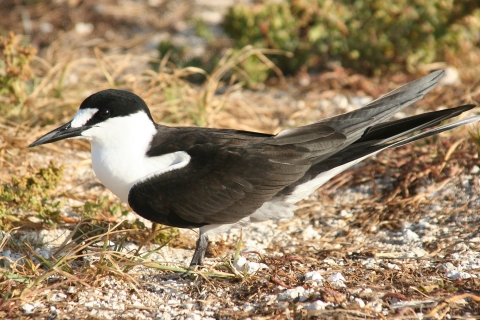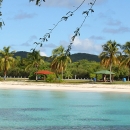About Us
Established in 1983, Culebra National Wildlife Refuge prioritizes breeding grounds for native birds and the conservation, management, and restoration of other wildlife, and plant resources and their habitats.
Our Mission
Culebra National Wildlife Refuge was established under Executive Order 1042 on February 27, 1909, with the primary goal of designating the area as “a refuge and breeding ground for native birds.” Various researchers have highlighted the critical importance of Culebra NWR for seabird populations, emphasizing the need to protect its nesting colonies, which are noted for being one of the most significant concentrations of birds in the West Indies (Kepler and Kepler, 1978).
According to Schaffner (1994), Culebra NWR hosts the only remaining seabird nesting population of substantial size that is managed by the U.S. Fish and Wildlife Service in the Caribbean. However, both seabirds and the dry forest habitat within the refuge have been adversely affected by invasive species invasive species
An invasive species is any plant or animal that has spread or been introduced into a new area where they are, or could, cause harm to the environment, economy, or human, animal, or plant health. Their unwelcome presence can destroy ecosystems and cost millions of dollars.
Learn more about invasive species .
Luis Peña Cay, a small cay covering approximately 342 acres, is home to a significant colony of White-tailed Tropicbirds, with around 16 to 20 nests reported each year. Additionally, Red-billed Tropicbirds and a few nests of Audubon’s Shearwater have also been observed on this cay. Culebrita Island, located northeast of the main island of Culebra, is another vital area, spanning 260 acres.
Culebra National Wildlife Refuge's main objectives include:
Our History
In 1909, a significant part of the Culebra Archipelago was designated as a wildlife reserve through an Executive Order signed by President Theodore Roosevelt. Initially, the U.S. Navy was responsible for managing the Culebra lands, with the wildlife reserve designation depending on naval and lighthouse activities.
For many years, several of the smaller islands in the archipelago, along with the Flamenco Peninsula, served as sites for gunnery and bombing practice conducted by the U.S. Navy and Marine Corps. This military use continued until their departure in 1976.
In 1977, key portions of the lands previously administered by the Navy were transferred to the Commonwealth of Puerto Rico, while other areas were handed over to the United States Fish and Wildlife Service. The local management of the refuge began in 1983.
Today, approximately one-quarter of the total landmass of the Culebra Archipelago is designated as part of the Culebra National Wildlife Refuge, covering around 1,510 acres. This refuge plays a vital role in preserving the unique wildlife and natural beauty of the region.
Our Habitats
Puerto Rico's geologic history helps explain its diverse vegetation. Located at the eastern end of a vast oceanic volcanic mountain range, the island has undergone significant climate changes over time. During past glacial periods, the climate was cooler and drier, with sea levels dropping as much as 100 meters. Up until about 11,000 years ago, Culebra, Vieques, and the Virgin Islands (excluding St. Croix) were all connected to Puerto Rico, forming a landmass known as the Puerto Rican Bank, which was twice the size of the island today. As sea levels rose, these islands became separate but still shared many plant and animal species.
In the last 200 years, Culebra has changed dramatically due to human activities such as agriculture, military training, housing development, and tourism. Most areas of the island have been altered, except for small, hard-to-reach sections like the boulder forest at Mount Resaca. Former agricultural lands and military ranges typically revert to dense thorn thickets and secondary growth forests, which are common in the subtropical dry forest life zone.
There are six distinct habitat communities on Culebra Island and its surrounding cays, each contributing to the island's rich biodiversity. Below, you'll find descriptions of these unique habitats.
___________________________________________________________________________________________________________
Beaches
The beautiful crystalline waters of the beach are not just for the enjoyment of the community and visitors but also serve as habitat for many animal and plant species. Beach community vegetation occupies the upper open sandy beaches, rocky shorelines, and adjacent sea salt spray zones encompassing the island. This vegetation extends into some low-lying areas above the beach and is under the influence of saltwater, salt spray, and sea winds. Most of the species in this zone are pan-tropical and indigenous or secondarily distributed, such asbayhops and coconut Palm. As you explore, you'll notice the resilient grasses and vines that blanket the upper beach, creating beautiful, dense mats of greenery. You will also find unique wildflowers like coastal searocket and enjoy the vibrant blooms of seagrape as they adorn the landscape. Venturing into the rocky shores, the surf brings life to colorful algae and hardy plants, making every visit a chance to connect with nature. The stunning contrast of animal life and vegetation will inspire you to appreciate this unique habitat not just as a great place to have fun but also for the beautiful, dynamic, and indispensable ecosystem it is.
___________________________________________________________________________________________________________
Mangrove Forests
___________________________________________________________________________________________________________
Coastal Strand Forests
This unique type forest can only be found in the narrow coastal areas behind the beaches and mangrove forests. In the protected spots behind sand dunes, a richer and taller scrub grows, known as Beard's (1944) “littoral woodland.” This snakebark (coffee colubrina) shrubland alliance is diverse with many species of lianas, the shrubs blacktorch, baycedar, and prickly bush and occasionally dense stands of pinguin. The vegetation diversity of coastal strand forest is high and is composed of other characteristic species such as: tietongue, seagrape, Elaeodendron xylocarpum, key byrsonima, West Indian birch, white cedar, and several types ofEugenia species. The unique vegetation diversity and positioning of this type of forest makes it a habitat that contributes significantly to environmental health and community resilience!
___________________________________________________________________________________________________________
Lagoons
___________________________________________________________________________________________________________
Dry Forests and Shrub
___________________________________________________________________________________________________________
Other Facilities in this Complex
Culebra National Wildlife Refuge is one of the nine refuges that comprise the Caribbean Islands National Wildlife Refuge Complex. Each refuge in this complex plays a vital role in conserving endemic, native, migratory, and resident species, along with their habitats and the invaluable natural resources of the Caribbean.









